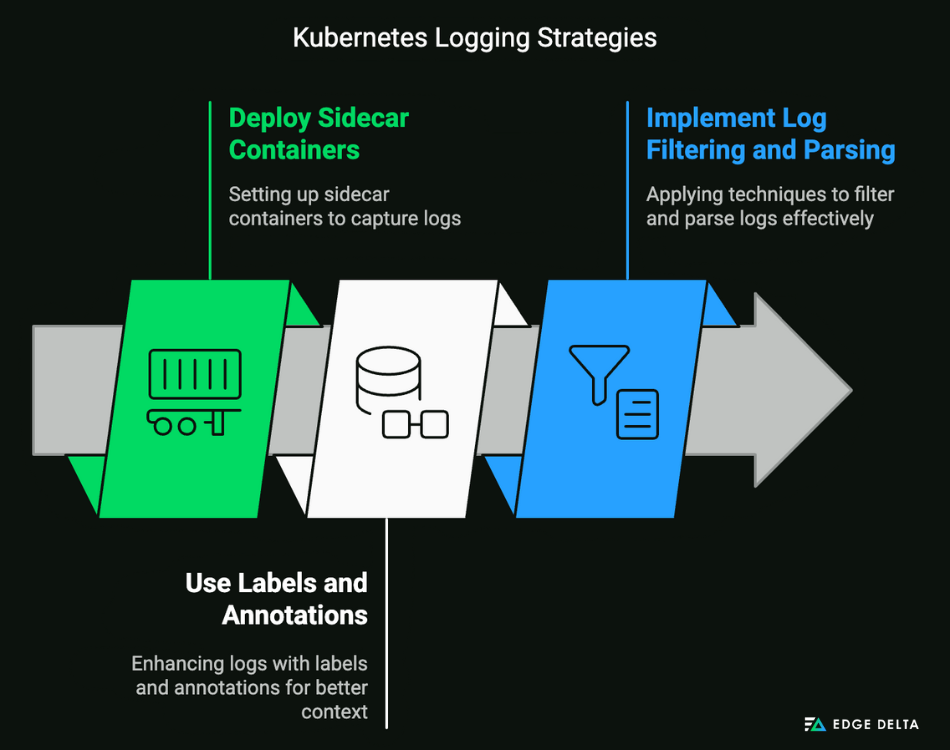Kubernetes logging is the process of collecting, storing, and evaluating logs from Kubernetes components and applications within a cluster. This process is essential for effective application monitoring and debugging.
Implementing efficient Kubernetes logging techniques enables reliability and proactive maintenance of containerized applications. It is crucial to maintaining visibility, resolving problems, handling complicated environments, and ensuring security and compliance.
This article covers Kubernetes logging, including its challenges, recommended best practices, and effective strategies.
| Key Takeaways: • Kubernetes logging involves collecting, storing, and analyzing logs from various components, such as nodes, pods, and containers. • Effective logging is crucial for maintaining application visibility, addressing issues, managing dynamic environments, and ensuring security and compliance. • Key challenges include log collection in distributed environments, log aggregation and centralization, and log monitoring for ephemeral containerized logs. • Efficient log management requires setting log retention and rotation policies, using Kubernetes-native logging tools, and adopting structured logging. • Adopting and implementing best practices can enhance an organization’s Kubernetes logging setup. |
Understanding Kubernetes Logging
Kubernetes logging involves collecting, storing, and analyzing logs generated by various Kubernetes cluster components, including nodes, pods, and containers. The logs generated by each are essential for tracking and debugging.
- Nodes: The primary node is responsible for monitoring the Kubernetes control plane and producing logs on cluster coordination and management. Worker nodes execute application workloads and produce logs related to their performance and execution.
- Pods: In Kubernetes, pods are the smallest units that may be deployed and contain one or more containers. Each pod creates logs that offer data about the status and actions of the apps running within it.
- Containers: Individual application processes are executed in containers, which also generate logs including the output and errors of these processes.
Challenges in Kubernetes Logging
Although Kubernetes logging is crucial for monitoring, troubleshooting, and maintaining a cluster’s health, it presents several challenges. The dynamic and distributed nature of Kubernetes environments complicates log management, requiring reliable solutions to ensure full visibility.
Challenge 1: Log Collection Across Distributed Environments
Effective aggregation and analysis of logs generated by various nodes and containers spread across the cluster can be challenging. Logs may be stored in various formats and locations, complicating the process of collecting them.
Each node and container can generate numerous logs. Because they are ephemeral, they disappear if not promptly caught.
| COMMON LOG COLLECTION CHALLENGES | |
| Challenge | Impact |
| Varied Log Locations | Complexity of collecting and analyzing logs. |
| Distributed Nodes | Challenges in aggregating and centralizing logs |
| Ephemeral Containers | Loss of vital performance and debugging information |
Challenge 2: Log Aggregation and Centralization
Aggregating and centralizing logs from Kubernetes clusters is challenging due to the environment’s highly dynamic and distributed nature. Each component in a Kubernetes cluster, including pods, containers, and nodes, generates its logs.
Organizations usually use cloud-based logging services, Fluentd, or centralized logging solutions like the ELK Stack (Elasticsearch, Logstash, Kibana) to handle these challenges. These tools help collect, standardize, and aggregate logs from several sources, offering a centralized interface for analysis and visualization. Implementing this method can significantly improve Kubernetes cluster monitoring and troubleshooting.
Challenge 3: Monitoring and Analyzing Containerized Logs
Since pods are constantly formed, destroyed, and moved across nodes, the Kubernetes logging procedure becomes more complicated. By addressing these issues with the right tools and techniques, organizations can efficiently monitor and analyze containerized logs in Kubernetes.
Using the appropriate tool is crucial to ensuring enhanced visibility, troubleshooting, and general administration of your Kubernetes infrastructure. Below is a table comparing tools for Kubernetes log monitoring.
| KUBERNETES LOG MONITORING TOOLS | ||
| Tool | Description | Key Features |
| Prometheus | Open-source data collector | Time-series database, alerting |
| Grafana | Open-source visualization tool | Rich visualizations and notifications |
| ELK Stack | Elasticsearch, Logstash, and Kibana Suite | Analytics and full-text searching |
| Fluentd | Open-source data collector | Scalable, centralized logging |
| Splunk | Log management and analysis platform | Enhanced search and real-time analysis |
Best Practices for Kubernetes Logging
For managing and debugging Kubernetes applications, efficient logging is essential. Following best practices can ensure that your logs offer insightful information, make debugging easier, and support cluster health maintenance.
These are a few key strategies to improve your Kubernetes logging procedure.
Best Practice 1: Adopt Structured Logging
Structured logging is the process of formatting log entries in a uniform, predictable manner, typically in JSON. This approach makes it easy to parse, search through, and analyze logs, which is helpful when correlating logs from different components in a Kubernetes context.
By using structured logging, you may take advantage of strong log analysis tools and methods, which will enhance your Kubernetes clusters’ observability and maintainability in the long run.
Best Practice 2: Utilize Kubernetes Native Logging Tools
Kubernetes native logging tools are designed to integrate seamlessly with Kubernetes environments, providing efficient logging solutions. By using these tools, you may improve efficiency, reliability, and simplicity of use by ensuring that your logging infrastructure is well-aligned with the Kubernetes ecosystem.
Organizations can achieve efficient and effective log management tailored to their Kubernetes settings by utilizing native logging tools. Here are two of the most common native logging tools:
| KUBERNETES NATIVE LOGGING TOOLS | |
| Tools | Key Features |
| Fluentd | Collecting, processing, and transmitting data |
| Loki | Logging compilation and analysis |
Best Practice 3: Implement Log Retention and Rotation Policies
Setting up log rotation and retention policies is a crucial component of effective Kubernetes log management. These policies help manage storage effectively by preventing log files from using up too much disk space and ensuring that essential log data is kept for the required amount of time.
Here are several benefits of rotation and log retention policies:
- Effective Storage Management: This technique lowers the storage burden and enhances system performance by eliminating unnecessary log data.
- Management: Logs prevent excessive disk space usage.
- Compliance: Ensures that logs are kept for the required time to comply with legal obligations.
- Cost Control: Reduces storage expenses by keeping only the log data that is required.
Efficient Kubernetes Logging Strategies
Effective logging is required to maintain the functionality and health of apps operating in Kubernetes clusters. By implementing effective Kubernetes logging practices, you can ensure that your logs are well-organized, easily accessible, and offer insightful information for monitoring and troubleshooting.
Here are a few of the best practices to help you get the most out of your Kubernetes logging.

Strategy 1: Deploy Sidecar Containers for Logging
One effective way to handle and gather logs apart from your application containers is to use sidecar containers for logging. Log gathering, processing, and forwarding are handled by sidecar containers, which operate in the same pod as your application containers. By ensuring that logging routines are kept separate from the program, this method encourages modularity and makes log management easier.
Strategy 2: Use Labels and Annotations for Log Enrichment
An efficient way to increase the value of your logs is to use Kubernetes labels and annotations to add metadata to your log data. Annotations and labels add context, which can improve the readability and analysis of logs. Adding pertinent metadata to log entries aids with compliance, monitoring, and troubleshooting.
Using annotations and labels for log enrichment can significantly enhance the quality and usefulness of your log data. This gives you a better understanding of the behavior and environment of your application and facilitates the diagnosis of problems, performance monitoring, and ensuring compliance with various standards.
Below is a table showing common metadata enrichment techniques.
| LOG ENRICHMENT TECHNIQUES | ||
| Metadata Type | Technique | Example |
| Environment | Labels | environment=production |
| Application Info | Annotations | app=web-service |
| Version Info | Labels/Annotations | version=v1.2.3 |
Strategy 3: Implement Effective Log Filtering and Parsing
To effectively extract relevant data from the vast amounts of log data generated in Kubernetes systems, log filtering and parsing must be implemented. You can lower noise, concentrate on significant log entries, and obtain insightful knowledge about the problems and performance of your application by employing filtering and parsing techniques.
You can streamline your log management process and focus on the most relevant data for your analysis and troubleshooting by employing efficient log filtering and parsing procedures. This process helps the Kubernetes environment provide improved performance monitoring, faster issue response, and more effective resource usage.
Conclusion
By implementing Kubernetes logging best practices, organizations can enhance their logging processes and create a more robust application environment, better monitoring, and faster troubleshooting. In addition to helping to keep your cluster healthy, efficient logging allows you to proactively handle problems and ensure peak reliability and performance.
FAQs on Kubernetes Logging
What is the logging limit for Kubernetes?
There is no hard logging limit imposed by Kubernetes itself.
Which logging is best for Kubernetes?
The organization’s specific needs will determine which Kubernetes logging solution is ideal for the team.
Do Kubernetes services have logs?
Logs are generated by the components with which Kubernetes services interact, such as pods and containers.
What is logging in Kubernetes?
Logging in Kubernetes includes collecting and organizing logs produced by cluster nodes, containers, and pods.
Sources:






